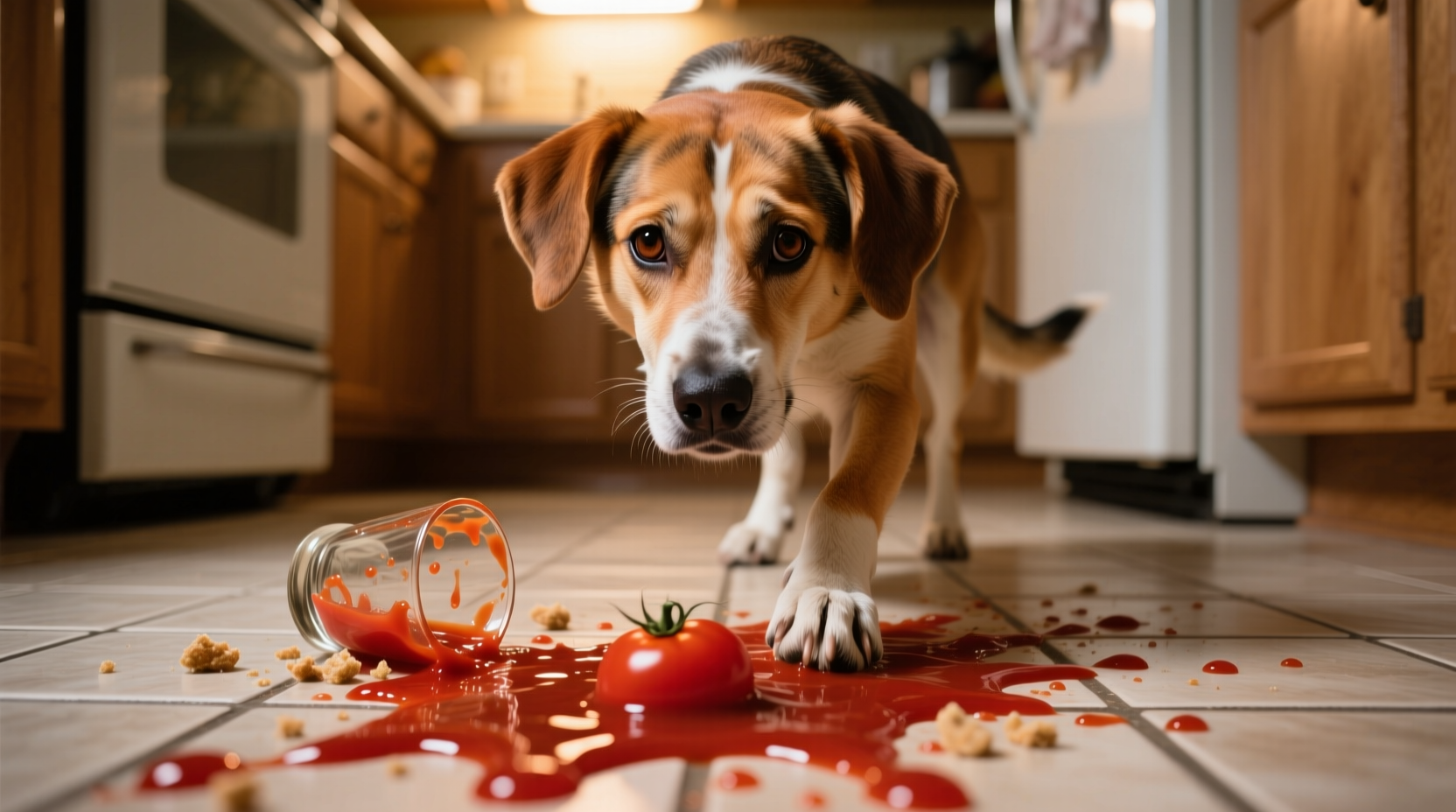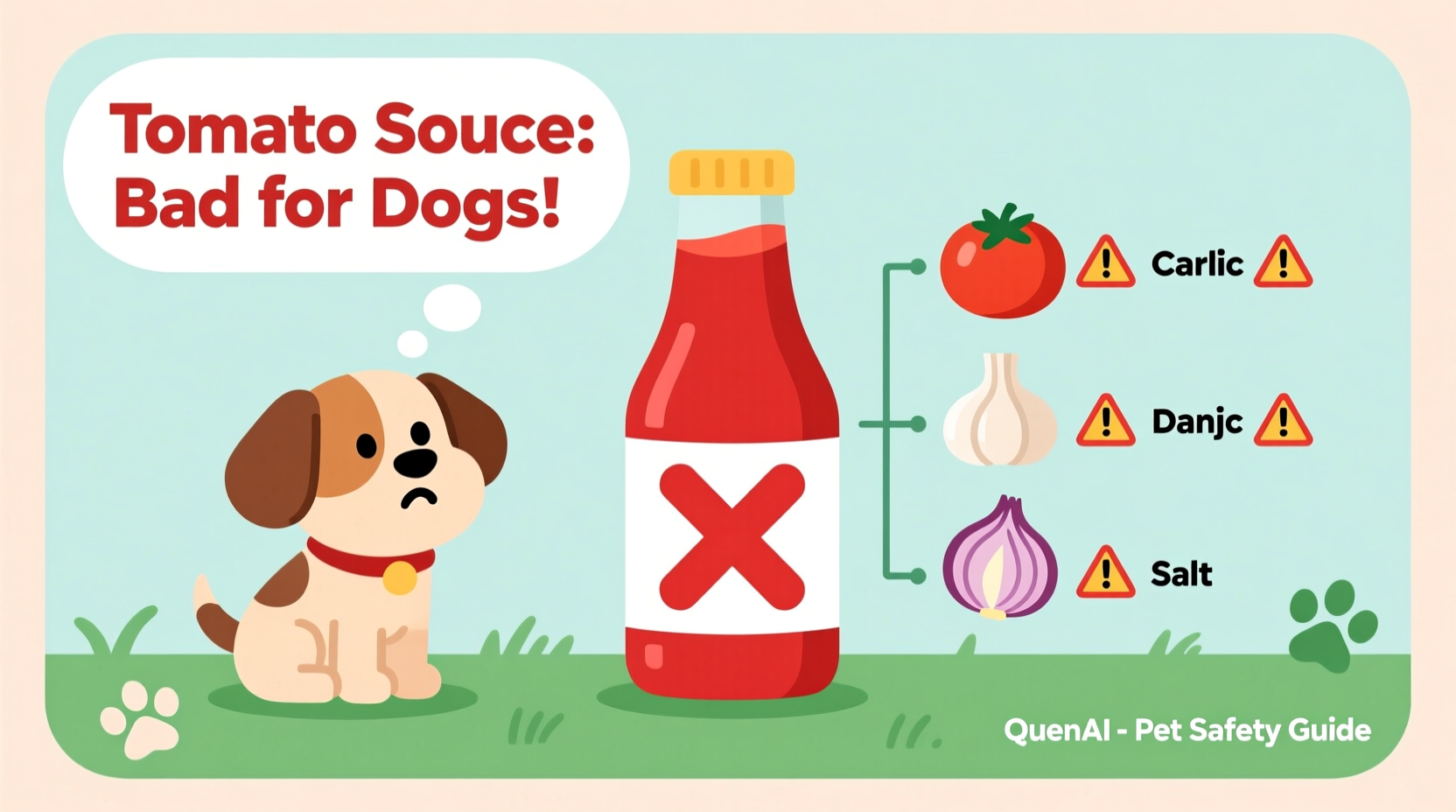Many pet owners wonder whether sharing a bite of pasta with tomato sauce is safe for their canine companions. The reality is that store-bought tomato sauce contains multiple ingredients harmful to dogs, making it a risky choice for your furry friend. Let's examine exactly why tomato sauce poses dangers and what you should do if your dog accidentally consumes it.
Why Tomato Sauce Is Dangerous for Dogs: The Ingredient Breakdown
While ripe tomatoes themselves are generally safe in small quantities, commercial tomato sauce contains several problematic components. Understanding these ingredients helps explain why tomato sauce should be kept away from dogs.
| Ingredient | Typical Amount in Sauce | Effect on Dogs | Severity Level |
|---|---|---|---|
| Garlic | 0.5-2% per serving | Damages red blood cells, causes hemolytic anemia | High (toxic at 15-30g per kg body weight) |
| Onion | 1-3% per serving | Same mechanism as garlic, cumulative toxicity | High (toxic at 5g per kg body weight) |
| Sodium | 200-400mg per 2 tbsp | Dehydration, electrolyte imbalance, sodium ion poisoning | Moderate to High |
| Tomato Plants (Stems/Leaves) | Trace in commercial sauce | Tomatine poisoning (gastrointestinal upset) | Low to Moderate |
Immediate Risks: What Happens When Dogs Eat Tomato Sauce
When your dog consumes tomato sauce, the toxic ingredients begin affecting their system within hours. Garlic and onion compounds oxidize red blood cells, causing them to rupture. This process, called hemolysis, can lead to life-threatening anemia. The ASPCA Animal Poison Control Center reports that symptoms typically appear 24-72 hours after ingestion, making early intervention critical.
According to veterinary toxicology studies published by the American Veterinary Medical Association, dogs show varying sensitivity to Allium species (garlic and onions). Japanese breeds like Akitas and Shiba Inus demonstrate heightened vulnerability due to genetic factors affecting their red blood cell structure.

Symptoms to Watch For After Ingestion
Monitor your dog closely for these warning signs if they've consumed tomato sauce:
- Weakness and lethargy (often the first noticeable symptom)
- Pale or yellow-tinged gums
- Increased heart rate and breathing difficulty
- Vomiting and diarrhea
- Red or brown urine (indicates hemoglobin in urine)
- Loss of appetite
Action Plan: What to Do If Your Dog Ate Tomato Sauce
Time matters when dealing with potential tomato sauce poisoning. Follow these steps immediately:
- Calculate the amount consumed: Check the sauce container to determine how much your dog might have eaten. Even 2-3 tablespoons could be dangerous for small breeds.
- Contact your veterinarian: Provide details about the sauce ingredients and estimated consumption amount. Don't wait for symptoms to appear.
- Preserve evidence: Keep the sauce container for ingredient verification. Take photos if you've discarded the container.
- Monitor vital signs: Check gum color, breathing rate, and energy levels every 30 minutes until you reach the vet.
- Follow professional guidance: Your vet may recommend inducing vomiting only if done within 2 hours of ingestion and under professional supervision.
When Small Amounts Might Be Less Concerning
Context matters when assessing risk. While commercial tomato sauce should generally be avoided, certain scenarios present lower risk:
- Homemade sauce without alliums: Tomato sauce made without garlic or onions poses significantly less risk, though high acidity may still cause stomach upset.
- Minimal exposure: A single lick of sauce containing small amounts of garlic/onion typically won't cause poisoning in medium to large dogs.
- Processed tomato products: Small amounts of tomato paste or canned tomatoes (without seasonings) are generally safe in moderation.
However, repeated exposure to even small amounts of garlic and onion can lead to cumulative toxicity. The Merck Veterinary Manual notes that chronic exposure to lower doses can be just as dangerous as a single large ingestion.
Safe Alternatives for Dogs Who Enjoy Tomato Flavors
If your dog seems interested in tomato flavors, consider these safer options:
- Fresh ripe tomatoes: Small amounts of seedless, ripe tomato flesh (¼ teaspoon per 10 pounds of body weight)
- Tomato-based dog treats: Commercially prepared dog treats specifically formulated with safe tomato content
- Vegetable broth: Low-sodium, onion/garlic-free broth for adding flavor to dog food
Always introduce new foods gradually and monitor for any adverse reactions. Remember that dogs don't require tomatoes in their diet, so these should be occasional treats rather than regular additions.
When to Seek Emergency Veterinary Care
Contact your veterinarian immediately if your dog shows any of these critical symptoms after consuming tomato sauce:
- Difficulty breathing or rapid breathing
- Severe lethargy or inability to stand
- Repeated vomiting or diarrhea
- Red or brown urine
- Gums that remain pale for more than 2 seconds after pressing
Early intervention significantly improves outcomes. Veterinary treatment may include intravenous fluids, oxygen therapy, and in severe cases, blood transfusions. The Animal Poison Control Center reports that with prompt treatment, most dogs recover fully from mild to moderate onion and garlic toxicity.











 浙公网安备
33010002000092号
浙公网安备
33010002000092号 浙B2-20120091-4
浙B2-20120091-4